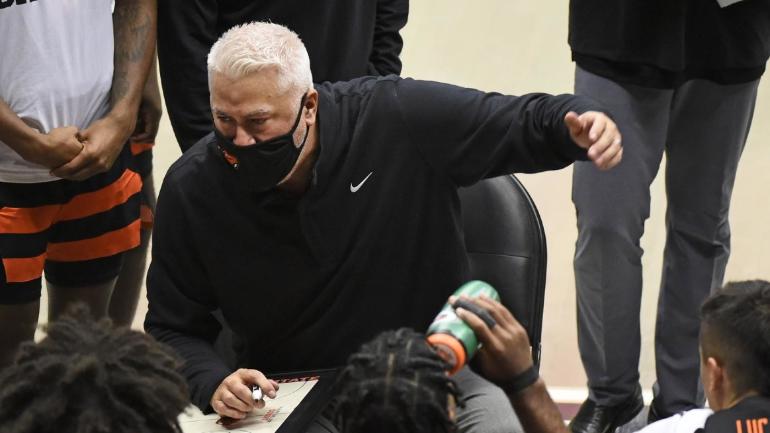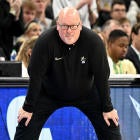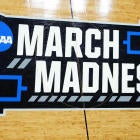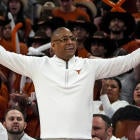
Just a few months ago, the Pac-12 was on track to be the last of the major conferences to allow its teams to begin playing basketball of any sort, let alone league games. The conference had announced a moratorium on all sports competition until 2021 due to the COVID-19 pandemic at a time when no other power conference had announced such a drastic move.
Fast forward to Nov. 25 at Gill Coliseum on the Oregon State campus, and not only was a Pac-12 program playing basketball, but it was playing a league game. Oregon State took on Cal in the first in-conference basketball game played in any league during the 2020-21 season.
The league continued with its early start this week as Washington State bested Oregon State 59-55 on Wednesday, with two more league games scheduled for Thursday. A year ago, the Pac-12 did not begin league play until the first week of January. But as it expands to a 20-game league slate this season, it is beginning league play well before any of the other six major conferences after abandoning its earlier plan to abstain from any competition until 2021.
"It's a little odd starting the Pac-12 so early in your schedule," Washington State coach Kyle Smith said before his team's league opener on Wednesday, which was just the Cougars' third game of the season. "I feel like without exhibitions and scrimmages, our first two games we had a couple of good contests that normally would be our scrimmages or exhibitions. We're kind of just going into it headfirst."
The drastic change by the Pac-12 from playing no games at all until 2021 to being the first of the 32 Division I conferences to begin league play (only 31 are playing this season as the Ivy League has already announced it is sitting out he 2020-21 season) is just one example of the oddities that have formed in college basketball scheduling amid the pandemic. In a season already filled with programs pausing activities and late scheduling cancellations and additions, there are a number of unusual nuances in the sport's scheduling structure.
Here are some of the others:
Conference back-to-backs
Half of the 32 conferences, including the ACC, have announced league schedules that include back-to-backs in which teams face off in the same location on consecutive days or with just one day in between games. The idea is to reduce the amount of travel required by programs amid the pandemic.
But it will create a dynamic never seen on a large scale in modern college basketball. Whereas teams usually get at least a couple of weeks -- and a change in venue -- between games against the same opponent, teams will now regularly be playing each other twice in a span of less than 48 hours in the same venue.
"I'm sure in preparation you'd like to think about holding off on showing something until the second game," Idaho coach Zac Claus said. "But if you're in a pinch and need a bucket, you may go to that play. I think as coaches that we are one-track minded and that we'll empty our bucket to try and get a win. But it'll have coaches minds racing."
Claus' Vandals team traveled to Portland, Oregon, last week to begin its season in the U.S. Bank Portland Invitational. But after they had already arrived and checked into their hotel, the event was canceled due to state policies relating to the pandemic. So as Claus prepared his team this week to open Big Sky play with games at Sacramento State on Thursday and Saturday, the strangeness of being one of the first in the country to play the same team twice on a road trip was not a primary concern.
"Honestly they could have thrown any proposed schedule at us, and we would have been excited," Claus said. "We're just looking forward to playing and thrilled to be back on the floor competing again."
The Big Sky along with the America East is one of two conferences that are giving its teams a day off in between consecutive games against the same team. Claus said he planned for his team to spend some time in the gym on Friday getting some light work in before the second game of the trip.
Nonconference games vs. conference foes
Teams in the Summit League will primarily play back-to-backs in league competition. But four schools from the conference are going in together on a multi-team event scheduled for next week that won't count in the conference standings. The Dakota Showcase scheduled for next Thursday through Saturday in Sioux Falls, South Dakota will bring South Dakota, South Dakota State, North Dakota and North Dakota State together for a three-day round robin in which all four teams play each other.
"This is unusual times with COVID to play non-league games against league opponents, but our goal is to get as many games in as possible as is the rest of the league," South Dakota coach Todd Lee said in a press release announcing the Direct Dakota Showcase.
Divisional structure
The MEAC slate is scheduled to feature some back-to-backs. But the league's primary change amid the pandemic is going to a divisional structure in which teams will play the same few teams three or four times rather than playing everyone in the league.
"The mental and physical health and safety of our student-athletes, coaches, staff and fans must be at the forefront," MEAC Commissioner Dennis E. Thomas said. "With that in mind, creative and innovative scheduling was required to accomplish our goals. Because of the COVID-19 pandemic, we had to restrict travel to regional competition. Hopefully, the type of schedule is for spring 2021 only."
The biggest change
The biggest change to the 2020-21 college basketball season will come at the end, however. The NCAA Division I Men's Basketball Committee revealed last month that it plans to move all of its preliminary round sites to a single host city.
"We have learned so much from monitoring other successful sporting events in the last several months, and it became clear it's not feasible to manage this complex championship in so many different states with the challenges presented by the pandemic," NCAA Senior Vice President of Basketball Dan Gavitt said. "However, we are developing a solid plan to present a safe, responsible and fantastic March Madness tournament unlike any other we've experienced."





















